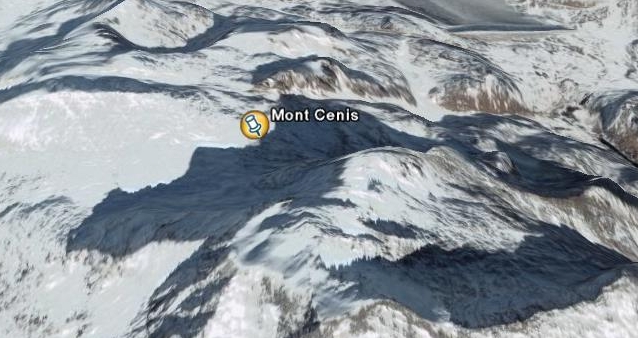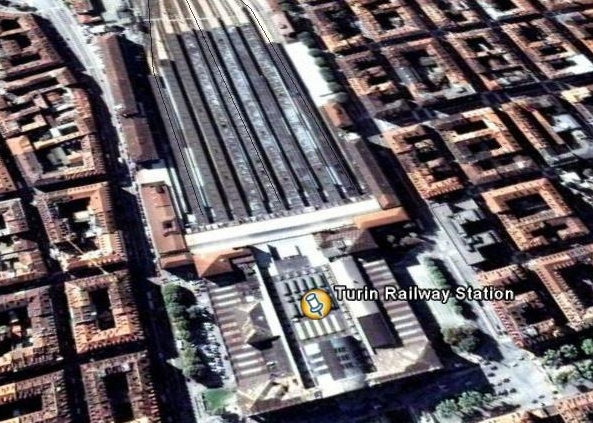BlankAfter the events of yesterday I feel quite glad to be in Italy. Mind
you it does mean I've been stuck in a train all day and had nothing of much
consequence to report (bar a small incident when I nearly forgot to close
the windows when passing through the Mont Cenis railway tunnel). Mmm,
there's an idea why not do a little summary on that tunnel and Turin (even
though we only spent 20 minutes in the town). First the Mont Cenis tunnel.
This tunnel clearly must be one of great Alpine tunnels to be completed. It
lies under the Fréjus Pass, from Modane, France, to Bardonècchia, Italy and
lasts a staggering 8½ miles long. It's construction was just as amazing as
it's length! It was driven from two headings between 1857 and last year
under the direction of Germain Sommeiller, and pioneered several techniques,
notably the use of dynamite in rock blasting, an improved rock drill
invented by Sommeiller, and compressed-air machinery developed by Daniel
Colladon of Geneva. When I get back, I shall have to see if Mr. Sommeiller
and Mr. Colladon would like to give the Reform Club a talk about their
achievements. Mount Cenis is the first long-distance rock tunnel driven from
two headings with no intervening shafts and will no doubt remain a landmark
engineering achievement for decades to come.
Now, Turin (or as Passepartout informed me today Torino as the Italians call
it). It's the capital of Torino province and of Piemonte region and is on
the Po River, near its junction with the Sangone, the Dora Riparia, and the
Stura di Lanzo. The original settlement of Taurisia, founded by the Taurini,
was partly destroyed by the Carthaginian invader Hannibal in 218 BC. It
later became a Roman military colony, known successively as Julia Taurinorum
and Augusta Taurinorum, rebuilt by the emperor Augustus in the form of an
enclosed rectangle divided into 72 insulae. The remains of the walls and the
Palatine Gate and the Palatine Towers are still visible. Dominated by
barbarians after the decline of Rome in the 4th century, the city became
part of the Lombard kingdom and then of the Frankish empire. It was linked
to Savoy in 1046 by the marriage of Countess Adelaide to Count Odo of Savoy,
and it recognized the supremacy of Savoy in 1280 after an intervening period
of semi-independence and conflict. Occupied by the French from 1536 to 1562,
Turin became the capital of the duchy of Savoy in 1563. It was besieged in
1640 and 1706 (during the War of the Spanish Succession) by the French, who
were defeated by Eugene of Savoy in 1706, and it was occupied again by the
French during the Napoleonic Wars. The city became the capital of the
kingdom of Sardinia in 1720 and in the 19th century became the political and
intellectual centre of the Risorgimento, the movement for Italian political
unification. It served as the first capital of a united Italy from 1861 to
1865 and if I was able to stay for any length of time would loved to have
explored this town in person.
Turin has been a bishopric since about 415 and an archbishopric since 1510
and is rich in ecclesiastical architecture. Noteworthy churches include the
Renaissance-style Cathedral of San Giovanni Battista (1492–98), with the
brilliantly original Santa Sindone Chapel (1667–90) by the Baroque architect
Guarino Guarini (both severely damaged by fire in April 1997); La Consolata
(1679; completed 1714), also by Guarini;the Waldensian Church (1850–53), the
first Protestant church in Turin; and the nearby Basilica of Superga
(1717–31), long the royalburial church. A ducal and royal city for
centuries, Turin has many fine palaces. The Madama Palace, begun in the 13th
century, owes its name to the resident-widows of the 17th-century dukes of
Savoy. Used by the Sardinian Senate in 1848–60 and by the Italian Senate in
1861–64, it now houses the Museum of Ancient Arts. The Carignano Palace
(1680), the birthplace (1820) of King Victor Emmanuel II and once the
meeting place of the Sardinian chamber of deputies and of the first Italian
Parliament, now houses the National Museum of the Italian Risorgimento. The
Royal Palace (1646–58) houses the Royal Armoury, with one of the finest
collections of arms in Europe. The Academy of Science (1678), formerly a
Jesuit college, now houses the Museum of Antiquities, the Egyptian Museum,
and the Sabauda Gallery. Other secular structures include the remains of the
old citadel; the Mole Antonelliana, begun in 1863 as a synagogue and later
completed by the city; the modern Turin Exhibition Buildings and Gallery of
Modern Art; and numerous public monuments to notable figures in Turin's
past. Other museums display collections on artillery, automobiles,
mountains, and natural history, zoology, paleontology, and mineralogy. There
are also several fine libraries. The University of Turin was founded in
1404. Other educational institutions include the Turin Polytechnic (1859),
the Gallery of the Albertina Academy (1652) and the Giuseppe Verdi State
Musical Conservatory (1867).
That's it. When I get back, I am making a beeline for Turin next summer. In
fact I can still see the mountains around Turin now and although it's just
turned October the peaks are deep in snow. I wonder if that Baron chap from
France who came to the Reform Club last year and had some very interesting
ideas about restarting the Olympic Games would be interested in developing a
winter version of the Olympic Games. Perhaps I should suggest holding one of
them in Turin. Anyway, see you tomorrow as we leave Europe and head towards
Africa.
--
No virus found in this outgoing message.
Checked by AVG Free Edition.
Version: 7.1.407 / Virus Database: 268.12.11/460 - Release Date: 01/10/2006
___________________________________________________________
Inbox full of spam? Get leading spam protection and 1GB storage with All New Yahoo! Mail.
http://uk.docs.yahoo.com/nowyoucan.html
Received on Thu 05 Oct 2006 - 10:44:36 IST



 JV.Gilead.org.il
JV.Gilead.org.il